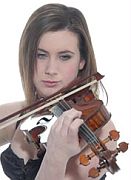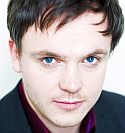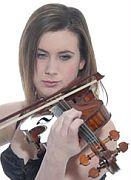The Bay Area is blessed with enough music-lovers and enough enterprising concert presenters that few musicians spend long at the top rank without swinging through here on some tour or other. Still, I suppose I’m not alone among SFCV readers in anticipating the appearance of musicians I’ve read about (or heard on record), but who’ve not yet performed here.

Chloë Hanslip is a young (21) violinist who has been recording for the better part of a decade — recording everything from John Adams to some of the more obscure 19th-century violinist/composers. (Does that make her exceptionally versatile, you wonder, or just eager for exposure?) Here she was in person, finally, in a program that was nothing if not ambitious (Beethoven’s “Kreutzer” Sonata and Prokofiev’s Op. 80 Sonata were the major pieces), accompanied by a young British pianist, Ashley Wass, about whom there has likewise been a certain amount of buzz.
Thanks once more to San Francisco Performances — both for taking a chance on two players that haven’t had much exposure in this country, and for (once again) guessing right. Hanslip and Wass are two names worth remembering.

Hanslip, on the Herbst Theatre stage, looked even younger than she is. She wore a sleeveless gown with straps she kept needing to pull furtively back into place, and her demeanor while playing had a strange combination of naturalness and unsuccessful artifice. (Her sudden gestures and her instinctive movement with Wass, I believed; the theatrically grand way she lifted her bow off the string at the close of any long passage, not so much.) But she sounds like a seasoned artist, and an interestingly individual one at that.
Her sound is intense and strikingly powerful, her vibrato fast, wide-ish, and inclined to be just a little over the note. She also uses nonvibrato tone a great deal — sometimes obviously for effect, but also, occasionally, on one or more notes in a passage where everything else is vibrated, which can get irritating. She has a taste for big gestures and thrilling climaxes, but, unlike some of her less savvy contemporaries, she doesn’t play that way all the time. I was impressed by her willingness to play on a small scale when it was appropriate, given the amount of sound she was capable of putting out.
She had the good fortune to be partnered by a pianist of similar inclinations and talent. Wass makes a thunderous sound, especially toward the bass of the instrument, and the things that stood out in Sunday’s big pieces were the bluster of the first movement of the “Kreutzer” and the deep clangor of the grittier passages of the Prokofiev. But his touch in the quietest music was as fine. In the eerie third movement of the Prokofiev, Hanslip’s sound was a little present, a little too real, while his was hauntingly remote.
Verve and Variety
In the two big sonatas, Hanslip proved to have an arresting taste in timbres and inflection. Both pieces are full of technical awkwardnesses, and neither sounded exactly easy for her. But in the Beethoven her variety and verve of articulation carried her over the few slightly messy passages. And in the Prokofiev, there was a sort of patient intensity, allied to a willingness to dare unusual sounds, that more than made up for the odd smudged note. I’ve heard the piece’s famous swirling scales played more evenly and cleanly — in fact, I suspect that half the people programming the work do it just to show off that particular skill. But Hanslip’s ghostly, half-articulate noise is the more effective way of rendering what is, after all, an “effect.”
As a curtain-raiser before the Beethoven, the duo played Brahms’ C-Minor Scherzo (the “Sonatenzatz”). There was a time, not long ago, when the work (Brahms’ contribution to a jointly composed sonata in honor of the violinist Joseph Joachim) might as well never have been written, to judge by recordings and recital programs; now, it seems almost overexposed. Hanslip and Wass were impassioned and exciting here, treating the piece as though it were a movement of a full Brahms sonata rather than as a tidbit.
The program’s biggest curiosity was something billed as a Shostakovich violin sonata — not the late sonata, Op. 134, written for Oistrakh and played in Berkeley by Sergey and Lusine Khachatryan a few weeks back, but a fragment dating from 1945-1946 recently completed by Mark Fitz-Gerald. A terse press release led me to comment erroneously, in my Khachatryan review, that Hanslip was proposing to play both Op. 134 and the Prokofiev F-Minor Sonata on the same program. Fortunately that wasn’t the case.
Unfortunately, what she and Wass did play isn’t quite a viable work. The program notes to Sunday’s recital don’t make clear how extensive were the sketches Fitz-Gerald worked from, but judging by the result I would guess that there was relatively little completed music there. As completed, the piece has two themes — a slow, lyrical one in G minor over an arpeggiated triplet accompaniment, and a faster, more acerbic one, in a polkalike vein. Fitz-Gerald’s completion alternates the two twice, finally rounding the fragment off with a third, brief reappearance of the opening music.
The materials are enough like those of Shostakovich’s other chamber music from around the same time that I kept thinking I recognized things from other works. Eventually I tracked down one persistent nagging resemblance in the “polka” music to the first movement of the Second String Quartet, though another turn (I think) belongs to the E-Minor Piano Trio. (Those two works, Opp. 68 and 67 respectively, both date from 1944.)
Like the abortive quartet fragment that the Alexander Quartet gave its premiere performances and recording a few years ago, this is interesting to hear, but not likely to make its way into the permanent repertoire. Hanslip and Wass applied the same steely devotion they gave the Prokofiev, which is to say that I doubt it will ever be much better played.
Paganini Caprices
Following that came something, in its way, nearly as obscure. Karol Szymanowski’s piano-accompanied versions of three of the Paganini Caprices (originally for solo violin) were fascinating and not a little bewildering. “Filling out” solo string music is nothing new. Lots of people, for example, did it with Bach’s solo string suites and sonatas, beginning with Bach himself, and if you browse around among early-20th-century virtuosos’ recordings of the Paganini Caprices, you will find some with piano accompaniments.
Not like these, though. Szymanowski’s arrangements don’t mess much with the violin writing (though in the famous 24th Caprice the variations are radically reordered), but the piano plays merry havoc with the violin’s implied harmony, adding slithery countermelodies and unsuspected harmonic implications left and right. It’s not an accompaniment; it’s one of those recompositions that works by swallowing the original whole, like some of the more ornate of Godowsky’s Chopin étude arrangements or (less radically) those charming second-piano parts Grieg wrote to several Mozart keyboard sonatas.
Apart from sending the listener into a series of frantic double-takes, the piano parts have the virtue, from the violinist’s perspective, of obscuring detail in a few of the more impossible passages. It’s assistance that did Hanslip some good in places, because while she was determined and fiery, she was nothing like immaculate. (She came to particular grief in the variation of the 24th Caprice that has a new, legato countertheme in octaves on the D and G strings — violinists will know the one I mean. Alas, that was one place where Szymanowski’s version left her entirely audible.)
Hanslip does have the temperament to pull such music off, though. And if she lacks the adamantine control of one or two currently celebrated young virtuosos, she does also have facility to burn. Her encores were characteristic: both terrific, both unfashionably “old-school virtuoso,” and both played with old-school showmanship. First was Kreisler’s arrangement of Cyril Scott’s Lotus Land, a few minutes of deliciously retro, exotic, pentatonic lolling around. And then the inevitable Antonio Bazzini Ronde des lutins (Round-dance of the goblins) — inevitable, that is, from Hanslip, whose last recording was an entire disc of music by a guy we’d all thought of as a one-work composer.
This is, of course, the “one work”: a wicked compilation of various, violin-technical nasties into a madcap, frenzied little romp. It’s typically played by people with more chops than God, but not much else. I’ve heard it played more neatly than Hanslip did Sunday, but never with such devil-may-care swagger — or such velocity. The fusillade of left-hand pizzicato near the end was staggering.

